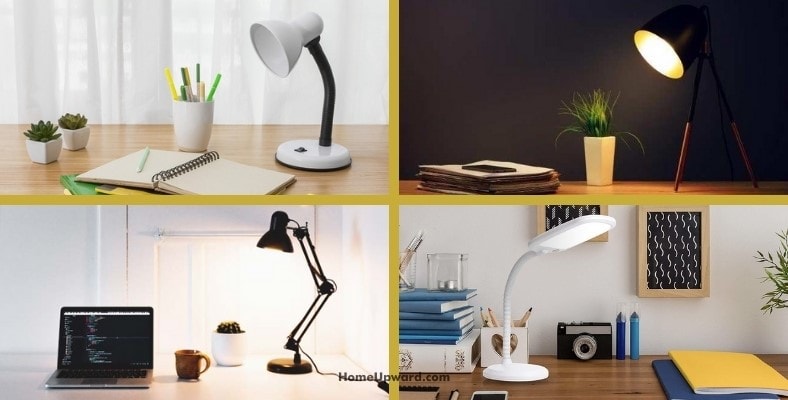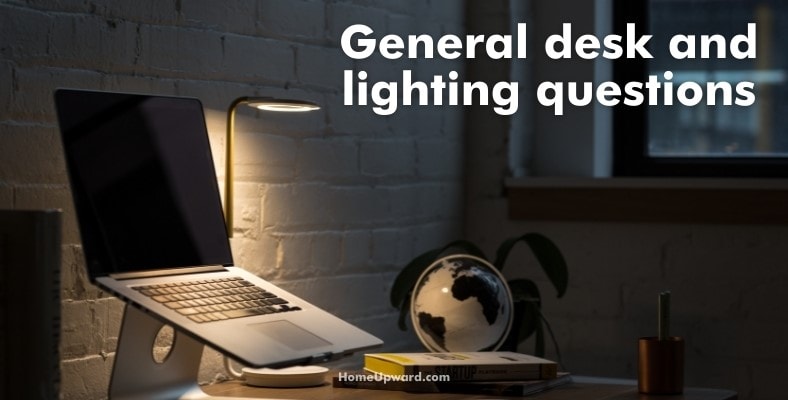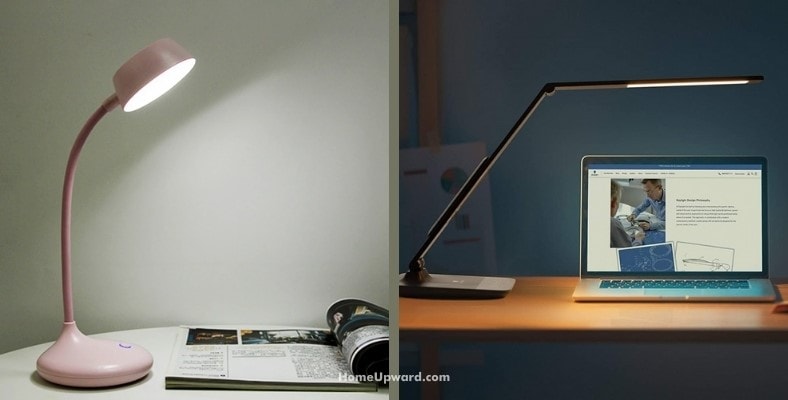Contents
How Should You Position a Desk Light?
How you choose to position a desk light will have a great deal to do with your daily activities. The positioning of a desk light for a home office with monitors will differ from one where you mostly do your reading.
Therefore, there are many factors to consider to make sure your unique desk set-up is lit adequately for your work to alleviate eye strain.
General Tips to Follow
The best overall rule to follow is to remember the purpose of a desk light: to illuminate your task and help support your focus while you work. As such, your desk light should always be aiming at the thing you need to see most.
This falls under the category of task lighting, which doesn’t aim to light the whole room but only seeks to light a specific task. Because of this, desk lamps usually only filter light downward toward the surface of a desk as opposed to up and out, like many accent lamps.
Computer Desk Lighting Position
If you work mostly with computer monitors at your desk, you won’t want to aim your desk light at the monitors themselves. Computers have back-lighting and shouldn’t need lamp lighting as well.
However, positioning your desk light to illuminate your keyboard and mouse will help your eyes quickly and easily follow along as you type, mitigating strain and aches while you work.
Using Lamp Lighting with Two Monitors
For a desk set-up with multiple monitors, traditional desk lamps will likely prove unfit for the lighting task. You need a lamp that can cast a wider amount of light over a focused space still without causing glare. Additionally, it can’t take up much space.
Using an adjustable-arm lamp with a lighting bar can help achieve this effect. Be careful to avoid flickering lights, such as low-quality LED bulbs, as their negative effects can be compounded when used alongside computer screens.
Good Desk Lamp Placement for Reading
For desk spaces that mainly host tasks like reading, use a taller lamp that can be positioned to cast light from the angle of your shoulder and the same height as your head. This is the optimal position for reducing eye strain while reading.
It also simulates natural light well, illuminating pages brightly enough for comfortable reading without producing a harsh or too-close lighting effect.
Of course, as always, natural lighting is the easiest on our eyes for working and reading. Take notice of the natural light conditions during the day in your desk area and replicate them as much as possible for a comfortably lit reading area.
Home Office Desk Lighting Recommendations
For a home desk area that is multi-use, it’s a good idea to find a lamp that can operate well for multiple kinds of focused tasks. Many lamps are highly adjustable in height, angle, position, and even color tone.
These kinds of lamps offer the widest range of working conditions that can take you from computer use to reading and writing with the least amount of strain or inconvenience.
For a home office with a computer, always place the lamp to the side and angled parallel to the screen but never at it. Consider the other sources of light in the room, both natural and artificial.
Light sources angled toward the desk from behind, above, and in front can all impede work by causing computer screen glare and eye strain. So make sure to position your lighting so that it shines directly onto the desk and not in your eyes or into the screen.
What Are the Features of a Good Desk Lamp?
Adjustability is the name of the game for desk lamps. These table lamps are made to provide different ranges of brightness and color temperature for day and night work under multiple different scenarios.
Here are some different adjustable features to consider when looking for a good desk lamp.
Halogen vs LED vs. Incandescent Bulb Lighting
LED and halogen lighting are more efficient than incandescent bulb lighting. Halogen bulbs offer a fixed color temperature, while LED lights are more adjustable and can offer brighter white-blue wavelengths for work.
LED lights can have a flicker effect that can cause headaches for sensitive users, but halogen and incandescent lighting are not as long-lasting or environmentally friendly.
Spring-Loaded and Gooseneck Lamps
A spring-loaded, or anglepoise, lamp operates with two spring-loaded arms that can adjust the height of the lamp and provide a lot of adjustability.
Gooseneck lamps are less rigid than spring-loaded ones and have necks that can be twisted and turned to adjust the angle and height of the light.
While anglepoise lamps have a more retro and substantial look, gooseneck lamps look more modern and are often more portable.
General Desk and Lighting Questions
Still stumped about how to position your desk lamp? Here are some frequently asked questions.
What’s the best angle for a desk lamp?
Traditionally, a 30-degree angle is perfect for lighting the surface of the desk while reducing glare on any screen as well as keeping the light out of your eyes. This angle helps mimic the way natural light shines.
How tall should a desk lamp be?
To make sure that your desk is lit brightly enough without lighting conditions that are too intense, select a lamp that is around 15 inches from the surface of your desk. This should be close to your head height from the desk as well.
What side of a desk should a lamp be?
Your desk lamp should be on the opposite side of your dominant hand. For example, right-handed people should place their lamps on the left side of their desks. Non-halogen desk lamps can be kept closer to you than those with a halogen bulb because of how much heat halogen bulbs produce. This helps alleviate shadows that can be bothersome and limit work productivity.
Choosing a good light color
Whether you work at your desk during the day or night will help decide which type of bulb is best for lighting your work conditions comfortably.
Warm White vs. Daylight Bulb Colors
Brighter white colors in the blue wavelength range are perfect for daytime work, as they’ve been proven to stimulate the mind and help increase focus.
For nighttime work or reading, warmer white tones in the yellow range are better for creating a calming atmosphere that won’t disrupt circadian sleep rhythms.
Choose a bulb that corresponds to your daily work conditions, or go for an adjustable LED bulb that can simulate both when needed.






